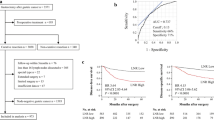Abstract
Research on the prognostic value of lymph node ratio (LNR) in gastric cancer (GC) remains limited and controversial results were obtained. In this study, we aimed to evaluate whether LNR was an independent prognostic factor for gastric carcinoma. A retrospective review of a database of gastric cancer patients was performed to determine the effect of the LNR on the overall survival (OS) and the disease-free survival (DFS). Of the total 135 patients with gastric cancer who underwent resection between March 2012 and December 2013, 44 patients with non metastatic gastric cancer were eligible for analysis. Survival curves were estimated using the Kaplan-Meier method. Cox regression analyses, after adjustments for potential confounders, were used to evaluate the relationship between the LNR and survival. According to the cutoff point 0.37 (37 %), the one-year OS rate for LNR ≤ 37 % was significantly better than that for LNR > 37 % (91.3 % and 61.9 %, respectively, P = 0.02). The one-year DFS for LNR ≤ 37 % was significantly better than that for LNR > 37 % (91.3 % and 66.7 %, respectively, P = 0.027). In stratified and multivariate analyses adjusted for age, gender, histology and tumor status, a higher LNR was associated with high pN stage and so associated with worse OS and DFS. Thus, the LNR 37 % as a cutoff point was found not to be an independent factor for predicting the one-year OS or DFS in patients with non-metastatic GC. The LNR is a prognostic factor in GC. However, no single cut-off value was determined as an independent prognostic factor.



Similar content being viewed by others

References
Jemal A, Bray F, Center MM, Ferlay J, Ward E, Forman D (2011) Global cancer statistics. CA Cancer J Clin 61:69–90
Hartgrink HH, Jansen EP, van Grieken NC, Van de Velde CJ (2009) Gastric cancer. Lancet 374:477–490
Wang XN, Liang H (2010) Some problems in the surgical treatment of gastric cancer. Chin J Cancer 29:369–373
Lee SY, Hwang I, Park YS, Gardner J, Ro JY (2010) Metastatic lymph node ratio in advanced gastric carcinoma: a better prognostic factor than number of metastatic lymph nodes? Int J Oncol 36(6):1461–1467
Fleming ID, Cooper JS, Henson DE, et al. (1997) American joint committee on cancer, cancer staging Manuel. Lippincott-Raven, Philadelphia, pp 71-76
Sobin LH, Wittekind CH (1997) International union against cancer (UICC): TMN classification of malignant tumors, 5th edn. John Wiley & Sons, New York
Lemmens VE, Dassen A (2011) E, van der wurff a a, coebergh JW and bosscha K: lymph node examination among patients with gastric cancer: variation between departments of pathology and prognostic impact of lymph node ratio. Eur J Surg Oncol 37:488–496
Persiani R, Rausei S, Biondi A, Boccia S, Cananzi F, D’Ugo D (2008) Ratio of metastatic lymph nodes: impact on staging and survival of gastric cancer. Eur J Surg Oncol 34:519–524
Inoue K, Nakane Y, Iiyama H, Sato M, Kanbara T, Nakai K, et al. (2002) The superiority of ratio-based lymph node staging in gastric carcinoma. Ann Surg Oncol 9:27–34
Bando E, Yonemura Y, Taniguchi K, Fushida S, Fujimura T, Miwa K (2002) Outcome of ratio of lymph node metastasis in gastric carcinoma. Ann Surg Oncol 9:775–784
Weir L, Speers C, D’yachkova Y, Olivotto IA (2002) Prognostic significance of the number of axillary lymph nodes removed in patients with node-negative breast cancer. J Clin Oncol 20:1793–1799
Herr HW, Bochner BH, Dalbagni G, Donat SM, Reuter VE, Bajorin DF (2002) Impact of the number of lymph nodes retrieved on outcome in patients with muscle invasive bladder cancer. J Urol 167:1295–1298
Berger AC, Watson JC, Ross EA, Hoffman JP (2004) The metastatic/examined lymph node ratio is an important prognostic factor after pancreaticoduodenectomy for pancreatic adenocarcinoma. Am Surg 70:235–240
Gajra A, Newman N, Gamble GP, Kohman LJ, Graziano SL (2003) Effect of number of lymph nodes sampled on outcome in patients with stage I non-small-cell lung cancer. J Clin Oncol 21:1029–1034
Attaallah W, Gunal O, Manukyan M (2013) Ozden G and yegen C: prognostic impact of the metastatic lymph node ratio on survival in rectal cancer. Ann Coloproctol 29(3):100–105
Wu HL, Tian Q, Peng CW, Liu SP, Li Y (2011) Multivariate survival and outcome analysis of 154 patients with gastric cancer at a single Chinese institution. Asian Pac J Cancer Prev 12:3341–3345
Nitti D, Marchet A, Olivieri M, Ambrosi A, Mencarelli R, Belluco C, Lise M (2003) Ratio between metastatic and examined lymph nodes is an independent prognostic factor after D2 resection for gastric cancer: analysis of a large European monoinstitutional experience. Ann Surg Oncol 10:1077–1085
Marchet A, Mocellin S, Ambrosi A, et al. (2007) The ratio between metastatic and examined lymph nodes (N ratio) is an independent prognostic factor in gastric cancer regardless of the type of lymphadenectomy. Ann Surg 245:543–552
Liu C, Lu P, Lu Y, Xu H, Wang S, Chen J (2007) Clinical implications of metastatic lymph node ratio in gastric cancer. BMC Cancer 7:200
Celen O, Yildirim E, Berberoglu U (2007) Prognostic impact of positive lymph node ratio in gastric carcinoma. J Surg Oncol 96:95–101
Zeng WJ, Hu WQ, Wang LW, et al. (2013) Lymph node ratio is a better prognosticator than lymph node status for gastric cancer: a retrospective study of 138 cases. Oncology Letters 6(6):1693–1700
Nelen SD, van Steenbergen LN, Dassen AE, van der Wurff AA, Lemmens VE, Bosscha K (2013) The lymph node ratio as a prognostic factor for gastric cancer. Acta Oncol 52(8):1751–1759
Author information
Authors and Affiliations
Corresponding author
Ethics declarations
Conflict of Interest
We hereby declare explicitly that we have no relationship with any third party of conflict of interest or a fund that support our study.
Rights and permissions
About this article
Cite this article
Attaallah, W., Uprak, K., Gunal, O. et al. Prognostic Impact of the Metastatic Lymph Node Ratio on Survival in Gastric Cancer. Indian J Surg Oncol 7, 67–72 (2016). https://doi.org/10.1007/s13193-016-0490-8
Received:
Accepted:
Published:
Issue Date:
DOI: https://doi.org/10.1007/s13193-016-0490-8



